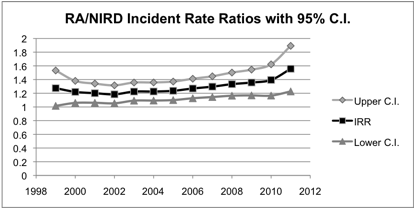Session Information
Title: Epidemiology and Public Health (ACR): Rheumatoid Arthritis and Systemic Lupus Erythematosus Outcomes
Session Type: Abstract Submissions (ACR)
Background/Purpose: Rheumatoid arthritis (RA) has consistently been associated with increased mortality risk, a risk that appears to be linked with greater disease activity. Although there have been substantial recent improvements in treatment, particularly with the availability of biologic treatments, it is unknown whether these advances have translated into improved RA-related survival. The purpose of this study was to describe and compare the trends in mortality in patients with RA and non-inflammatory rheumatic diseases (NIRD) from 1998 to 2011.
Methods: Patients were enrolled in a longitudinal study and open cohort of US rheumatologist diagnosed rheumatic diseases. Patients with RA and NIRD (osteoarthritis, back pain, tendonitis; excluding fibromyalgia) were followed from 1998 through 2011. Death records were obtained through the US National Death Index. Standardized mortality ratios (SMR) were calculated each year adjusting for age, sex, race, and calendar year. To account for possible participation bias, the RA group was compared to another enrolled group (NIRD) known to have an SMR close to or slightly lower than 1. Incidence rate ratios (IRR) comparing RA and NIRD groups and 95% confidence intervals were calculated each year controlling for age, sex, smoking status, disease duration, and comorbidity.
Results: In the RA group, 3,604 deaths occurred over 145,510 person-years. In the NIRD group, 965 deaths occurred over 40,003 person-years. SMR increased abruptly in the first three years in both groups. Annual SMRs were consistently higher for patients with RA (median 1.44, range 0.42 – 1.78) than for those with NIRD (median 0.88, range 0.09 – 1.35). Following multivariate adjustment, RA-related mortality risk remained significantly higher than NIRD mortality risk, a relative risk that remained constant throughout the observation period (IRR mean 1.29, range 1.18 – 1.56) (Figure).
Conclusion: Despite important advances in treatment that have accompanied the availability of biologics, there has been no meaningful improvement in RA-related mortality over this time period. As a result, there has been no narrowing of the “mortality gap” separating RA patients from patients with NIRD. Though caution is warranted in interpretation, it appears that this gap may actually be widening. To determine whether this trend continues will require additional follow-up.
Disclosure:
B. R. England,
None;
H. Sayles,
None;
T. R. Mikuls,
None;
K. Michaud,
None.
« Back to 2014 ACR/ARHP Annual Meeting
ACR Meeting Abstracts - https://acrabstracts.org/abstract/mortality-trends-in-rheumatoid-arthritis-during-the-biologic-era-1998-to-2011/

